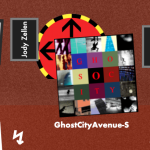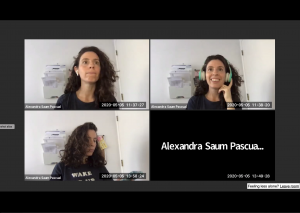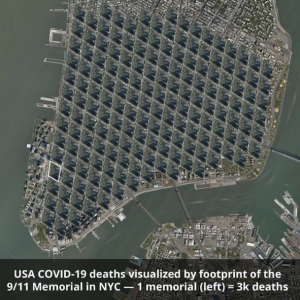COVID E-LIT: Digital Art from the Pandemic curatorial statement

Nacher, Rettberg, and Pold offer a curatorial statement about the COVID E-Lit Exhibition--one of the many exhibitions held at the ELO 2021 conference. This Exhibition in particular, they explain, focused on reactionary, reflexive, and recovery-based art in response to the COVID-19 pandemic.
Starting the preparatory phase of our research project almost one year ago, we were primarily interested in capturing the cultural moment of the then-nascent COVID pandemic through the lens of digital culture in general and electronic literature and digital art in particular. In the course of barely a couple of months in 2020, we witnessed the massive shift of transferring almost every aspect of our everyday life online. This quickly resulted both in an explosion of new forms of creativity and the acute syndrome of much-touted “Zoom fatigue”. The former were often mediated through popular platforms and brought new digital genres (such as Tik-Tok duets and the homemade reenactments of classic paintings), on top of already recognized but still under researched variants of meme culture or sometimes troubling discourse of subreddits. Although with the COVID-19 crisis digital networked platforms took center stage and corporations like Facebook, Google, Apple and Zoom still form the main interfaces to our public space, soon it became obvious that the digital culture of the pandemic coincides with surprising and disturbing developments, such as the noticeable move of far-right extremism towards the open-source, niche, and independent platforms such as PeerTube, Pleroma, MeWe, Zello, or infamous Parler. Another visible feature of the massive online shift related to what Naomi Klein has named “Screen New Deal”, where commercial technology platforms are introduced to a much larger extent and integrated with our private spaces and homes, is the development of new forms of critical reflection, e.g. about how platforms invade privacy, intimacy, individual spaces and simultaneously collaboration, communities, cultural and political life. Such a reflection often takes the form of digital artwork, available for download and functioning as the browser plug-in or add-on.

Yet, it seems the pandemic not only created a distinctive crisis of its own, but also exacerbated the ones that have long been in the making. Underfunded and inefficient public healthcare and education systems were the first to undergo the shock of sudden failure. In light of the famous Stafford Beer’s observation known as POSIWID (the purpose of the system is what it does), such failures became particularly illuminating and sobering to many who were prone to believe that the rich countries of the global North can maintain their global dominance and endless development at the expense of the environment and colonized “others”, including those suffering along the lines of various oppressive ideologies and systems of domination: racial, gender, class, ideological, and economic. Achille Mbembe in his illuminating essay “The Universal Right to Breathe”1 aptly remarks: “Before this virus, humanity was already threatened with suffocation” and warns that following the hitherto path will bring further destruction on an already unprecedented scale, where the economy of extraction based on and favoring fossil fuels is inevitably interlinked with our super-efficient and energy-hungry digital world. This is why we were also interested in how the pandemic digital art and e-literature tackled the wider crises of our contemporaneity: climate change, racial injustice, gender inequality and social inequality. Many works developed during this time are then reflective of public clashes and rebellion, e.g. in relation to Black Lives Matter, during a period in which dominant power structures are exposed and actively questioned. Furthermore, there are many works mourning the deceased, the sick, as well as the loss of human connections that were not long ago taken for granted.

On the other hand, since the outbreak of the pandemic, public libraries, theatres, museums, and cultural festivals have been closed to various degrees across many countries and much cultural life and many creative practices have moved online, along with their audiences. This alone posed significant challenges to the whole cultural sector, but was also seen as a chance to find new ways of communicating and new solutions to make cultural life more accessible to the various types of audiences. It seems, in the pandemic we have been collectively mourning the lost space of shared human presence and want to believe this loss is only temporary. This hope is being reflected in many artworks in the exhibition that confine with the near space, locality, nature, various constraints impacting embodiment practices, the home and homely. It has also manifested as a uniting thread running through the interviews we have conducted with many of the artists in the exhibition as an attempt at documenting our encounter with the artists and their work - embodied feelings and the treasured shared presence of our human body/minds around was discussed by each and every artist we talked to over Zoom in March 2021, working on a forthcoming documentary skillfully produced and videographed by Ashleigh Steele.
For many pandemic crisis has been experienced as both an intense, extended period relieved from FOMO, and as sheer boredom and utter restlessness. Most of us have experienced the intrusion of platforms like video conferencing into our very living rooms and bedrooms, which has led to the emergence of critical awareness but also to a way of getting used to being together across screens. In this sense, old distinctions between online and offline, the virtual and the physical and perhaps even art and reality have somewhat diffused themselves into new hybrids. And digital artists and elit authors reflect on analogue matters like bodies, homes, concrete environments and physical conflicts. Maybe we see traces of a new cultural moment, a sort of final goodbye to the false ideas of a weightless postmodernity, living in a mixture of digital media and reality that is no less real.
When this exhibition opens, we are more than a year into the pandemic experience. We have realized that the global is not elsewhere but directly interlinked with our infrastructures, travel, supply chains, contagion networks, etc. We are global, even when we are local and subject to lockdown and travel bans. The pandemic demonstrates that we are all connected, but it also points out that the conditions are still very different between rich and poorer countries, between countries on the same continents, neighborhoods in the same city or young and old citizens. We have been forced to live locally confined. In some cases this has been an enlightening and even spiritual experience, in other cases it has been a disaster. Our friends in dra.ft group in India are even now confronting a devastating surge in cases and deaths.

When we started discussing the Covid 19 and electronic literature, we reflected on the fact that, while there are many public memorials related to wars, there are very few related to epidemics and diseases. Apart from the horrible scenes we have seen from hospitals around the world, the everyday of the pandemic has for many of us mostly been visible through its lack of the normal, as closed down, deserted cities. There is something unrepresentable about a pandemic caused by an invisible virus. This exhibition portrays all this through art and electronic literature as, we hope, an already historical monument of life under the pandemic. We believe the exhibition demonstrates that the pandemic, besides all its horrors and cancellations, has also been a genuine moment for art and electronic literature.
Footnotes
-
Mbembe, The Universal Right to Breathe”, trans. C. Shred, https://critinq.wordpress.com/2020/04/13/the-universal-right-to-breathe/ ↩
Cite this essay
Nacher, Anna, Søren Pold and Scott Rettberg. "COVID E-LIT: Digital Art from the Pandemic curatorial statement" Electronic Book Review, 6 June 2021, https://doi.org/10.7273/kehh-8c36